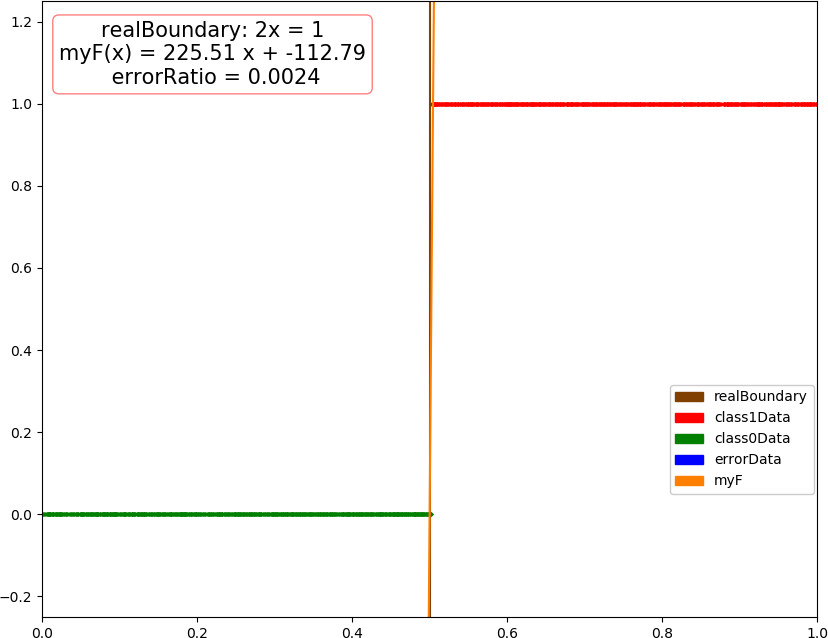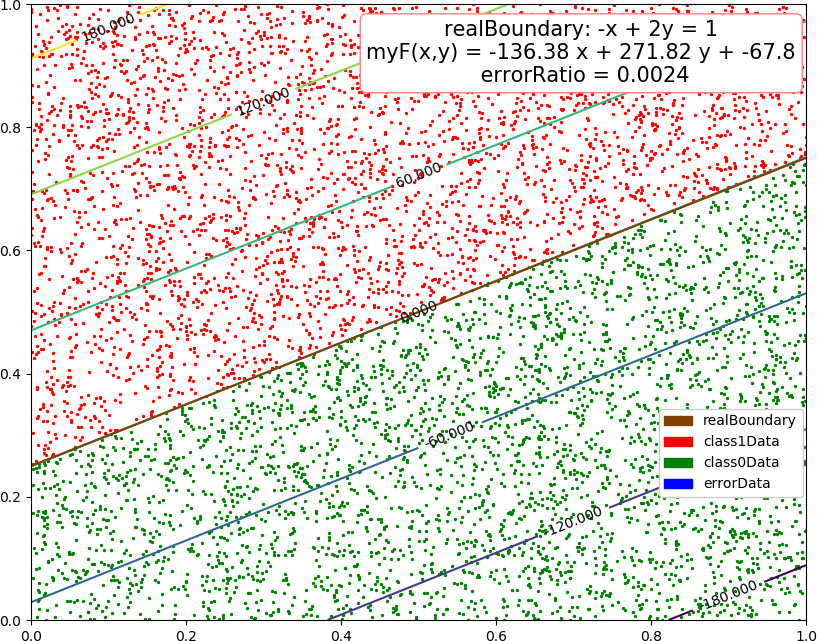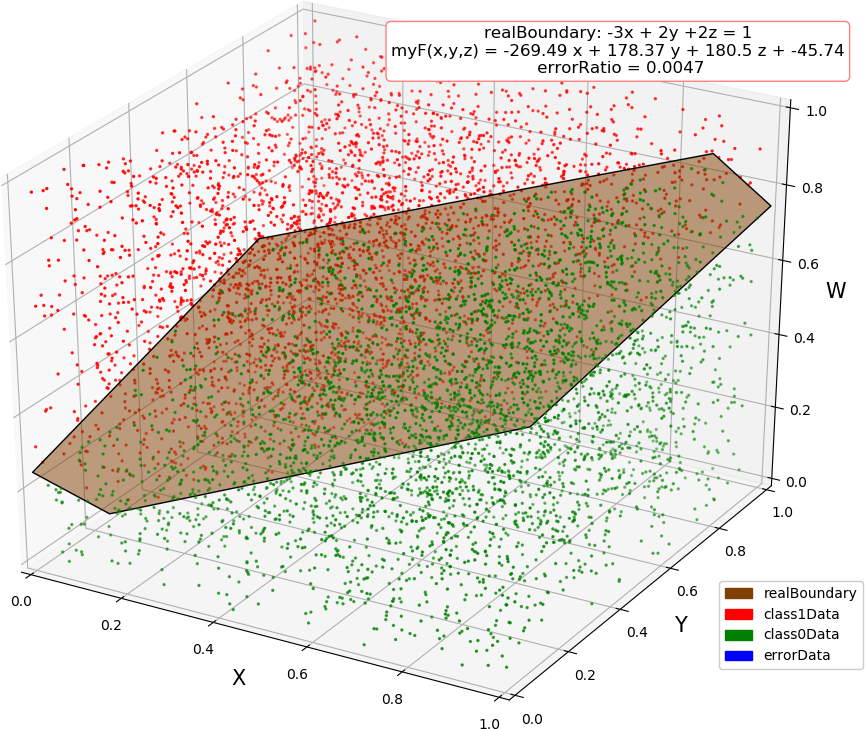▶ 使用逻辑回归来进行二分类,其中用到了梯度下降来进行数值优化
● 代码
1 import numpy as np 2 import matplotlib.pyplot as plt 3 from mpl_toolkits.mplot3d import Axes3D 4 from mpl_toolkits.mplot3d.art3d import Poly3DCollection 5 from matplotlib.patches import Rectangle 6 7 dataSize = 10000 8 trainRatio = 0.3 9 maxTurn = 500 10 ita = 0.1 11 epsilon = 0.005 12 13 colors = [[0.5,0.25,0],[1,0,0],[0,0.5,0],[0,0,1],[1,0.5,0]] # 棕红绿蓝橙 14 trans = 0.5 15 16 def dataSplit(x, y, part): 17 return x[:part], y[:part],x[part:],y[part:] 18 19 def sigmod(x): # 逻辑回归函数 20 return 1.0 / (1 + np.exp(-x)) 21 22 def function(x,para): # 连续回归函数 23 return np.sum(x * para[0]) + para[1] 24 25 def judge(x, para): # 分类函数,由乘加部分和阈值部分组成 26 return sigmod(function(x, para) - 0.5) 27 28 def createData(dim, kind, count = dataSize): # 创建数据集,给定属性维度,每属性取值数,类别数,样本数 29 np.random.seed(103) 30 X = np.random.rand(count, dim) 31 Y = ((3 - 2 * dim)*X[:,0] + 2 * np.sum(X[:,1:], 1) > 0.5).astype(int) 32 #print(output) 33 print("dim = %d, kind = %d, dataSize = %d"%(dim, kind, count)) 34 kindCount = np.zeros(kind ,dtype = int) # 各类别的占比 35 for i in range(count): 36 kindCount[Y[i]] += 1 37 for i in range(kind): 38 print("kind %d -> %4f"%(i, kindCount[i]/count)) 39 return X, Y 40 41 def logisticRegression(dataX, dataY): # 分类函数 42 count, dim = np.shape(dataX) 43 xE = np.concatenate((dataX, np.ones(count)[:,np.newaxis]), axis = 1) # x 增加一列 44 w = np.zeros(dim + 1) 45 finishFlag = False 46 turn = 0 47 while finishFlag == False and turn < maxTurn: # 计算似然函数 48 temp = sigmod(np.sum(xE * w, 1)) 49 error = dataY - temp 50 grad = np.sum(xE.T * error, 1) 51 w += ita * grad # 使用梯度下降法优化 w 52 turn += 1 53 #print("turn = ", turn, ", w = ", w, ", error = ", np.sum(np.abs(error)) / count) 54 if np.sum(np.abs(error)) < count * epsilon: 55 finishFlag = True 56 break 57 print("turn = ", turn, ", w = ", w) 58 return (w[:-1],w[-1]) 59 60 def test(dim, kind): 61 allX, allY = createData(dim, kind) 62 trainX, trainY, testX, testY = dataSplit(allX, allY, int(dataSize * trainRatio)) # 分离训练集 63 para = logisticRegression(trainX, trainY) 64 65 myResult = [ int(judge(i, para) > 0.5) for i in testX ] 66 errorRatio = np.sum((np.array(myResult) != testY).astype(int)) / (dataSize * (1 - trainRatio)) 67 print("dim = %d, errorRatio = %f"%(dim, round(errorRatio,4))) 68 if dim >= 4: # 4维以上不画图,只输出测试错误率 69 return 70 71 errorP = [] # 画图部分,测试数据集分为错误类,1 类和 0 类 72 class1 = [] 73 class0 = [] 74 for i in range(int(dataSize * (1-trainRatio))): 75 if int(myResult[i] > 0.5) * int(testY[i]) < 0: 76 errorP.append(testX[i]) 77 elif myResult[i] > 0.5: 78 class1.append(testX[i]) 79 else: 80 class0.append(testX[i]) 81 errorP = np.array(errorP) 82 class1 = np.array(class1) 83 class0 = np.array(class0) 84 85 fig = plt.figure(figsize=(10, 8)) 86 87 if dim == 1: 88 plt.xlim(0.0,1.0) 89 plt.ylim(-0.25,1.25) 90 plt.plot([0.5, 0.5], [-0.5, 1.25], color = colors[0],label = "realBoundary") 91 plt.plot([0, 1], [ function(i, para) for i in [0,1] ],color = colors[4], label = "myF") 92 plt.scatter(class1, np.ones(len(class1)),color = colors[1], s = 2,label = "class1Data") 93 plt.scatter(class0, np.zeros(len(class0)),color = colors[2], s = 2,label = "class0Data") 94 if len(errorP) != 0: 95 plt.scatter(errorP[:,0], errorP[:,1],color = colors[3], s = 16,label = "errorData") 96 plt.text(0.22, 1.12, "realBoundary: 2x = 1 myF(x) = " + str(round(para[0][0],2)) + " x + " + str(round(para[1],2)) + " errorRatio = " + str(round(errorRatio,4)), 97 size=15, ha="center", va="center", bbox=dict(boxstyle="round", ec=(1., 0.5, 0.5), fc=(1., 1., 1.))) 98 R = [Rectangle((0,0),0,0, color = colors[k]) for k in range(5)] 99 plt.legend(R, ["realBoundary", "class1Data", "class0Data", "errorData", "myF"], loc=[0.81, 0.2], ncol=1, numpoints=1, framealpha = 1) 100 101 if dim == 2: 102 plt.xlim(0.0,1.0) 103 plt.ylim(0.0,1.0) 104 plt.plot([0,1], [0.25,0.75], color = colors[0],label = "realBoundary") 105 xx = np.arange(0, 1 + 0.1, 0.1) 106 X,Y = np.meshgrid(xx, xx) 107 contour = plt.contour(X, Y, [ [ function((X[i,j],Y[i,j]), para) for j in range(11)] for i in range(11) ]) 108 plt.clabel(contour, fontsize = 10,colors='k') 109 plt.scatter(class1[:,0], class1[:,1],color = colors[1], s = 2,label = "class1Data") 110 plt.scatter(class0[:,0], class0[:,1],color = colors[2], s = 2,label = "class0Data") 111 if len(errorP) != 0: 112 plt.scatter(errorP[:,0], errorP[:,1],color = colors[3], s = 8,label = "errorData") 113 plt.text(0.71, 0.92, "realBoundary: -x + 2y = 1 myF(x,y) = " + str(round(para[0][0],2)) + " x + " + str(round(para[0][1],2)) + " y + " + str(round(para[1],2)) + " errorRatio = " + str(round(errorRatio,4)), 114 size = 15, ha="center", va="center", bbox=dict(boxstyle="round", ec=(1., 0.5, 0.5), fc=(1., 1., 1.))) 115 R = [Rectangle((0,0),0,0, color = colors[k]) for k in range(4)] 116 plt.legend(R, ["realBoundary", "class1Data", "class0Data", "errorData"], loc=[0.81, 0.2], ncol=1, numpoints=1, framealpha = 1) 117 118 if dim == 3: 119 ax = Axes3D(fig) 120 ax.set_xlim3d(0.0, 1.0) 121 ax.set_ylim3d(0.0, 1.0) 122 ax.set_zlim3d(0.0, 1.0) 123 ax.set_xlabel('X', fontdict={'size': 15, 'color': 'k'}) 124 ax.set_ylabel('Y', fontdict={'size': 15, 'color': 'k'}) 125 ax.set_zlabel('W', fontdict={'size': 15, 'color': 'k'}) 126 v = [(0, 0, 0.25), (0, 0.25, 0), (0.5, 1, 0), (1, 1, 0.75), (1, 0.75, 1), (0.5, 0, 1)] 127 f = [[0,1,2,3,4,5]] 128 poly3d = [[v[i] for i in j] for j in f] 129 ax.add_collection3d(Poly3DCollection(poly3d, edgecolor = 'k', facecolors = colors[0]+[trans], linewidths=1)) 130 ax.scatter(class1[:,0], class1[:,1],class1[:,2], color = colors[1], s = 2, label = "class1") 131 ax.scatter(class0[:,0], class0[:,1],class0[:,2], color = colors[2], s = 2, label = "class0") 132 if len(errorP) != 0: 133 ax.scatter(errorP[:,0], errorP[:,1],errorP[:,2], color = colors[3], s = 8, label = "errorData") 134 ax.text3D(0.75, 0.85, 1.15, "realBoundary: -3x + 2y +2z = 1 myF(x,y,z) = " + str(round(para[0][0],2)) + " x + " + 135 str(round(para[0][1],2)) + " y + " + str(round(para[0][2],2)) + " z + " + str(round(para[1],2)) + " errorRatio = " + str(round(errorRatio,4)), 136 size = 12, ha="center", va="center", bbox=dict(boxstyle="round", ec=(1, 0.5, 0.5), fc=(1, 1, 1))) 137 R = [Rectangle((0,0),0,0, color = colors[k]) for k in range(4)] 138 plt.legend(R, ["realBoundary", "class1Data", "class0Data", "errorData"], loc=[0.83, 0.1], ncol=1, numpoints=1, framealpha = 1) 139 140 fig.savefig("R:\dim" + str(dim) + ".png") 141 plt.close() 142 143 if __name__=='__main__': 144 test(1, 2) 145 test(2, 2) 146 test(3, 2) 147 test(4, 2) 148
● 输出结果
dim = 1, kind = 2, dataSize = 10000 kind 0 -> 0.491000 kind 1 -> 0.509000 turn = 500 , w = [ 225.51391655 -112.78995202] dim = 1, errorRatio = 0.002400 dim = 2, kind = 2, dataSize = 10000 kind 0 -> 0.504000 kind 1 -> 0.496000 turn = 500 , w = [-136.38367654 271.82263114 -67.80046401] dim = 2, errorRatio = 0.002400 dim = 3, kind = 2, dataSize = 10000 kind 0 -> 0.501800 kind 1 -> 0.498200 turn = 76 , w = [-269.48732449 178.37270183 180.50103751 -45.74231996] dim = 3, errorRatio = 0.004700 dim = 4, kind = 2, dataSize = 10000 kind 0 -> 0.503100 kind 1 -> 0.496900 turn = 74 , w = [-335.00400878 133.17805105 132.39352473 132.93672898 -31.98460298] dim = 4, errorRatio = 0.002100
● 画图


